

 |
 |
August 24th 2020, the sky was cloudy after sunset however the Met Office and Arome model had predicted a wide spread clear night, I was eager to get shooting nightscapes as we had now entered a moonless period and I was eager to test out the Canon 5D Mark IV and its high ISO capabilities with the Milky Way. A shoot was promptly arranged with photographer Paul Martin and we decided to just take a chance and head out and see what happened. Since the cloud situation looked to be a gamble we decided we would stay local, our plan was to head out the Omagh road and meet at An Creagan visitor's centre to check out the quality of the sky. Amazingly as I drove out the clouds dissipated rapidly as the atmosphere cooled and suddenly I was under a high quality clear dark sky, I made my way rapidly to our location as I couldn't wait to get set-up just in case it clouded over again.
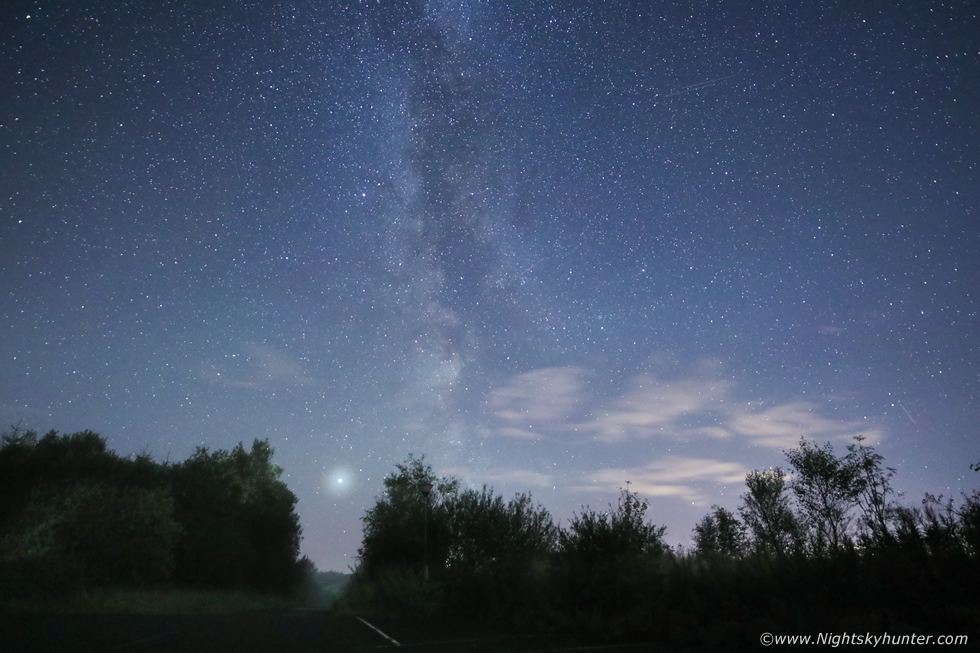 |
I had arrived a little early and was on my own but I wasted no time, I was straight out with 5D Mark IV mounted on tripod with Irix 15mm F/2.5 Blackstone lens and shooting within a minute of the van stopping. I was instantly amazed by the quality of the sky this night, not only was the background sky very dark the atmosphere was also very transparent with good seeing. This is 15 seconds at ISO6400 with lens stopped down to F/2.8. This was facing S/SW along the southern region of the Summer Triangle with the Milky Way dust clouds within Aquila, Scutum and Sagittarius. Planet Jupiter can be seen sporting a corona thanks to a bank of mist hanging over the road. The sky, camera and lens were really performing superbly this night, I was already getting my best Milky Way structure I've ever captured just using a static tripod. If you know your sky you will see the 'Coat Hanger' asterism jumping out from the background stars near the top of frame.
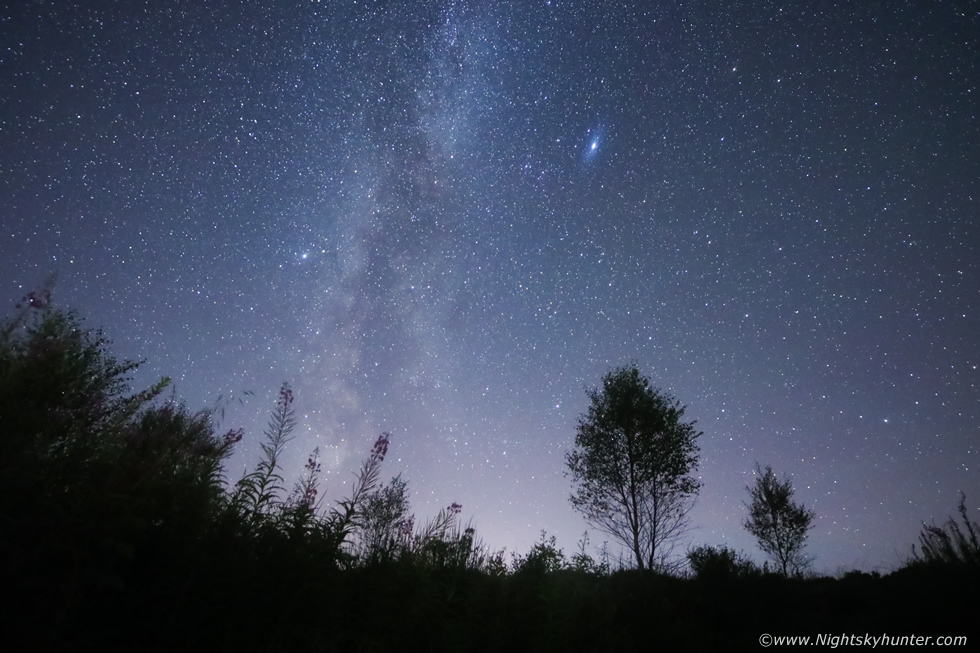 |
Paul arrived so we ventured around to the side of the visitor's centre which had a nice selection of trees which worked very well for foreground interest and which contrasted dramatically with the starry night. This is ancient bog land with a lot of history, the bog itself is 10,000 years old and likely contains the buried remains of bronze age settlements and people so it was only fitting to capture the majesty of the sky from this location, we realized this was likely the first time the night sky has ever been captured from here. The sky was absolutely amazing, Paul and I agreed it was the best night we had ever seen in 2020.
It was silent, still, not a breath of wind, we could feel the dew points climbing as more frequent banks of low mist formed over the bog land which passed near us several times and through that mist were planets Jupiter and Saturn setting over the horizon which was amazing to watch, you can see the light from Vega flaring due to the increasing dampness in the air. I had the camera set up on a picnic table here and began shooting a time lapse, with the 600D I began shooting a star trail of the building itself. Paul was shooting stills and fine tuning his compositions while we scanned the sky visually. I did what I have always done since I began observing and that was to undertake a naked eye dome search. By that I meaning carefully scanning the entire visible sky to make sure all is as it should be, in other words I'm checking if the sky is misbehaving, I check all the naked eye stars I know from memory from the last 20 years, including constellation checks and magnitude range.
This is a good thing to do in case a bright new Nova or Supernova has revealed itself just as the sky gets dark, such a thing would be on the social media as news travels fast however you could be among the first people to witness such an event if it manifested that very night, this happened before for a hand full of observers across N. Ireland when bright Nova Cygni appeared in 1975. Although such an event is rare a regular dome search is good practice, it keeps you familiar with the stars, improves your alertness, and maintains a good working knowledge of the night sky, furthermore such checks often reveal passing Iridium flare satellites, meteors, planes and perhaps a lucky fireball, the process also enhances your dark adaption and takes your mind away from the camera for a while, I always like to check the brightness and locations of well known variable stars such as Algol, Delta Cephei, Eta Aquilae, RCrB, the blank space of old Nova TCrB, the region above the centre star of Cassiopeia and the location of Chi Cygni. There's nothing better than seeing striking visual naked eye structure within the Milky Way from a dark sky and with full dark adaption, this image is my best I have taken to date. I reckon I likely had my best Milky Way time lapse however dew ruined many of the images but I got a short lapse from it and I had the still images so I was more than happy, I never thought I would capture so much detail on a single exposure so close to home.
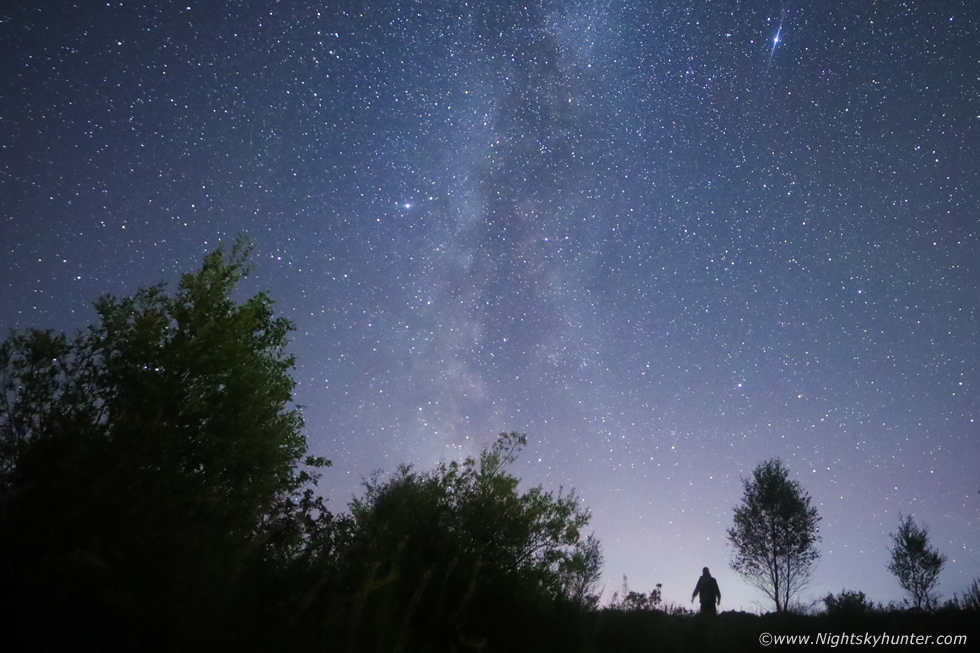 |
Paul stood in the frame for this one, when I capture scenes like this it's difficult to look back from shooting with full frame. The large sensor really does make a huge difference, a fast lens helps too, but the camera's ability to control noise at such extreme ISOs of 6400, 8000 and 1280 is simply remarkable. There was a time back in 2000 onward when Conor McDonald and I used our first digital cameras to undertake a photographic search for Novae. We would shoot regions of Cygnus, Aquila, Cepheus, Cassiopeia and Perseus, the camera picked up stars to mag +6 or even +7 when the images were brightened, then at home I would confirm every star on the images using my Sky Atlas.
We would do this every clear night, even in moonlight and always after a session of aurora watching or comet hunting so it became quite a habit. Look at how much camera technology has evolved since then, it would simply be impossible to check every part of this image to confirm each star and search for a new star in such a rich field, it would simply take too long the old fashioned way, I would say stars to at least mag +8 in the high resolution image, probably fainter in places. Paul is standing below my favorite region of the Milky Way in Aquila where it can be seen to split with two parallel rows of dust clouds disappearing into the horizon glow within Scutum.
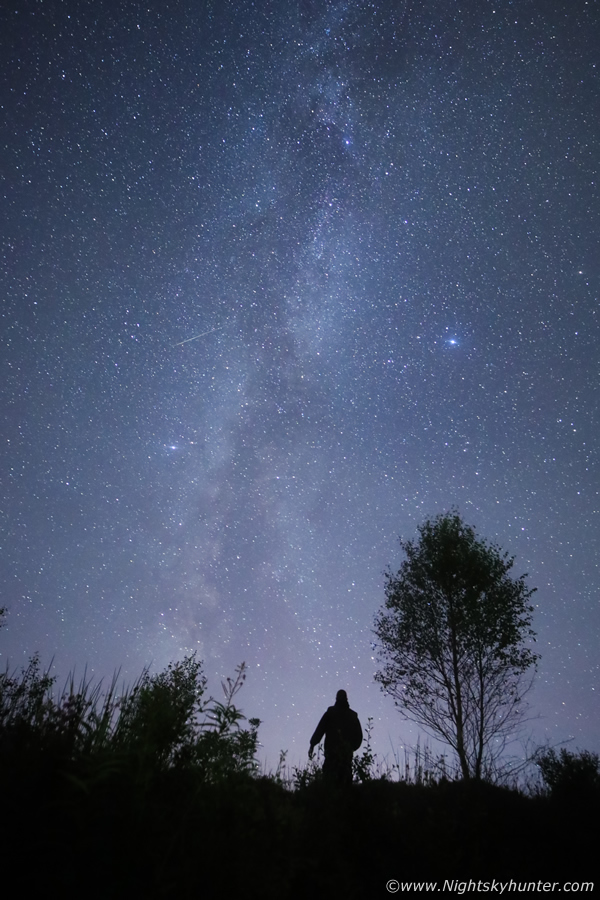 |
I asked Paul to stand in again for a portrait version and as I watched a mag +3 meteor zipped across the sky above him, you can see the trail above the star Altair. The mist increased and began to affect the transparency of the sky leaving our cameras and lenses absolutely soaked.
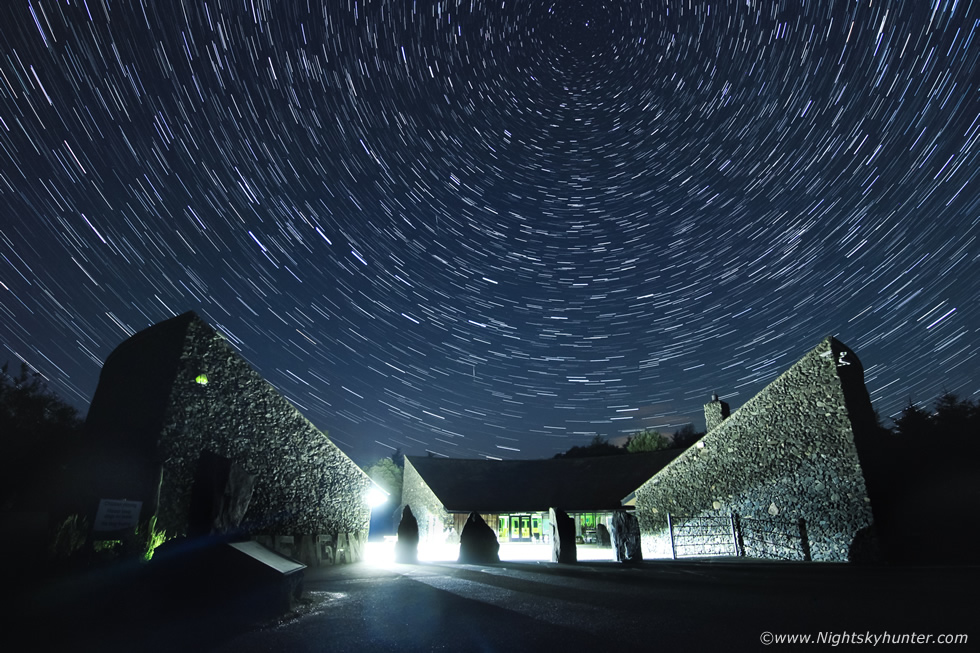 |
I checked my old faithful 600D which still delivers the goods, especially in conjunction with the Samyang 10mm F/2.8 lens, eventually many of the frames were affected by dew however I had enough images for this star trail. I'm fairly certain this is the first time this has been done here with the visitor's centre. A great night which surpassed all of our expectations with the best skies we have seen in a very long time, we called it a night at 01.30 and headed home feeling more than content.
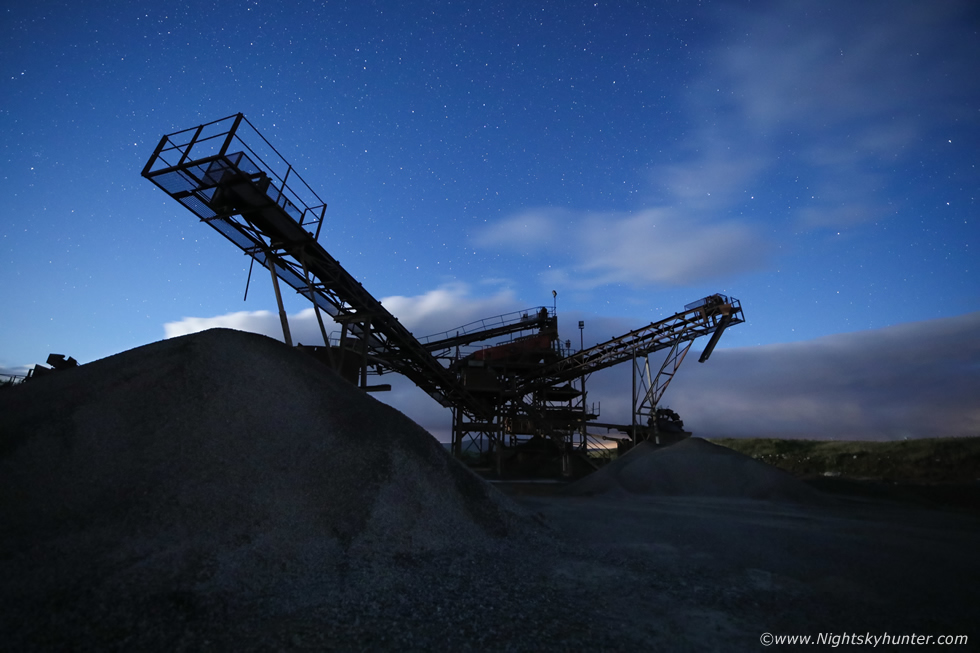 |
August 29th 2020, I have always wanted to shoot a quarry at night, when the first lock down ended I found an old quarry in Co. Tyrone and did a recce to make sure it was safe and doable for the night sky, it was, so I saved this location in the files for a future date. During the end of August John Fagan and I decided to do something about it, the night had a bright waxing moon which was low in the sky so we decided to give it a shot. Once again I set up two cameras shooting star trails and time lapse, the moon was perfectly located in the SW and lit the foreground brightly but with enough stars in the sky to work with. There was a selection of interesting subjects to shoot here however my main attention was drawn to this large sand/gravel separator, I don't know too much about quarry machinery and operations so I may be wrong, however whatever it is it sure is fascinating and made for a wonderful foreground subject. John and I walked around shooting from different angles, we were happy we made the decision to check this place out, it really was fascinating.
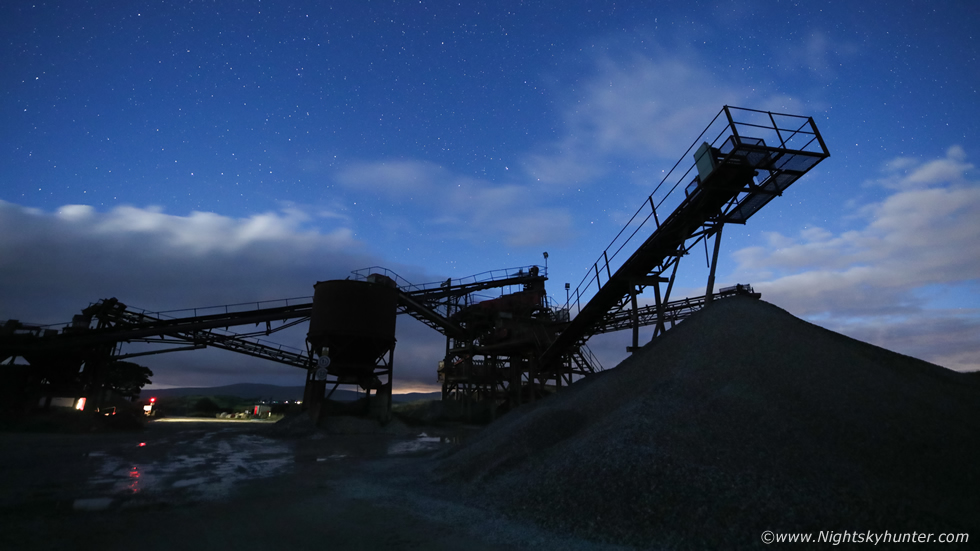 |
Facing N to NW in this angle with variable star RCrB visible in Corona Borealis at mag +6. Despite good clear spells those low clouds were a constant threat, the breeze was from the NE which isn't a good direction and despite a promising clear night from the Met Office we were concerned the sky could fill in with cloud quite quickly so we kept ourselves busy making the most of the clear breaks.
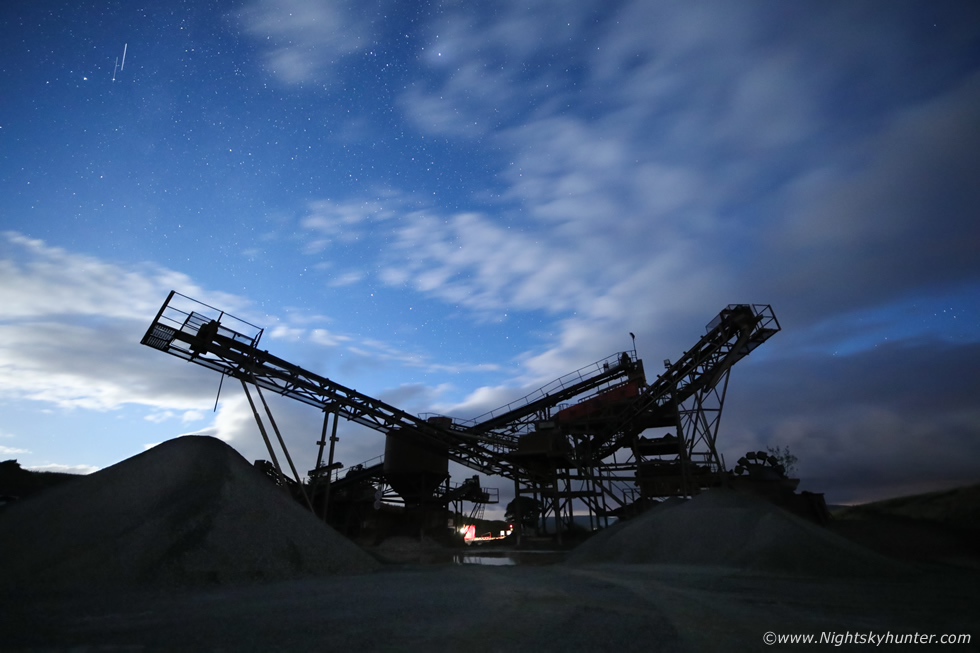 |
I really liked this angle facing more W to SW towards the Milky Way, however the glare from the nearby moon was in the frame, I made a mental note to try this again on a dark moonless night, note the two satellite trails near Altair, human engineering on the Earth vs human engineering in Space.
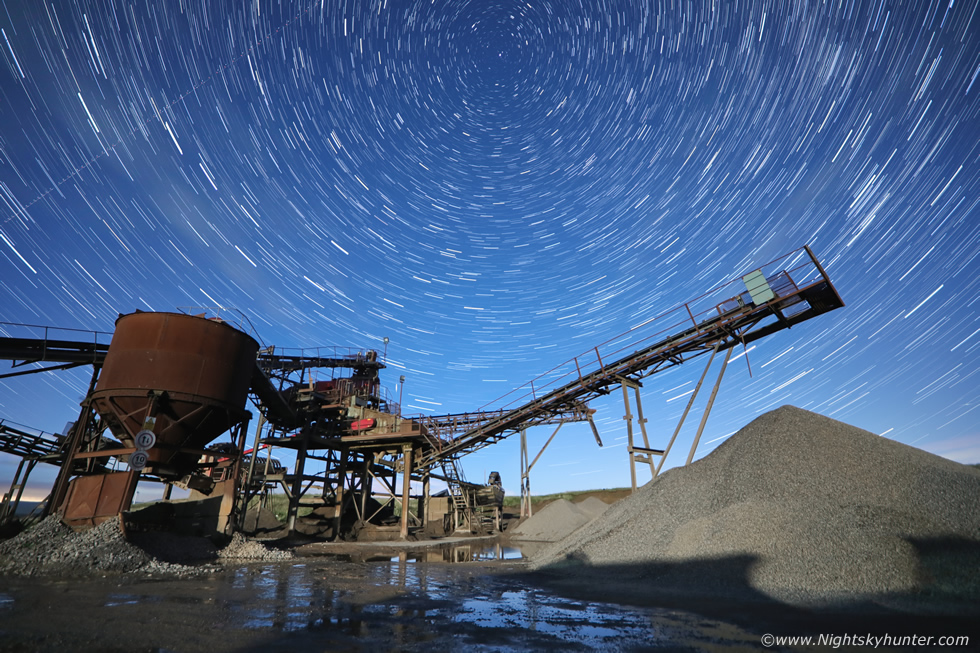 |
I was really happy with this, I didn't actually think a star trail would work out as I was shooting with time lapse in mind at a higher ISO so I reckoned that once the images were stacked for a trail the sky would blow out or look wrong, it was neither, the star trail worked perfectly. For anyone interested I'm now using Sequador for star trails, the results are cleaner and it seems to handle a wider dynamic range when stacking.
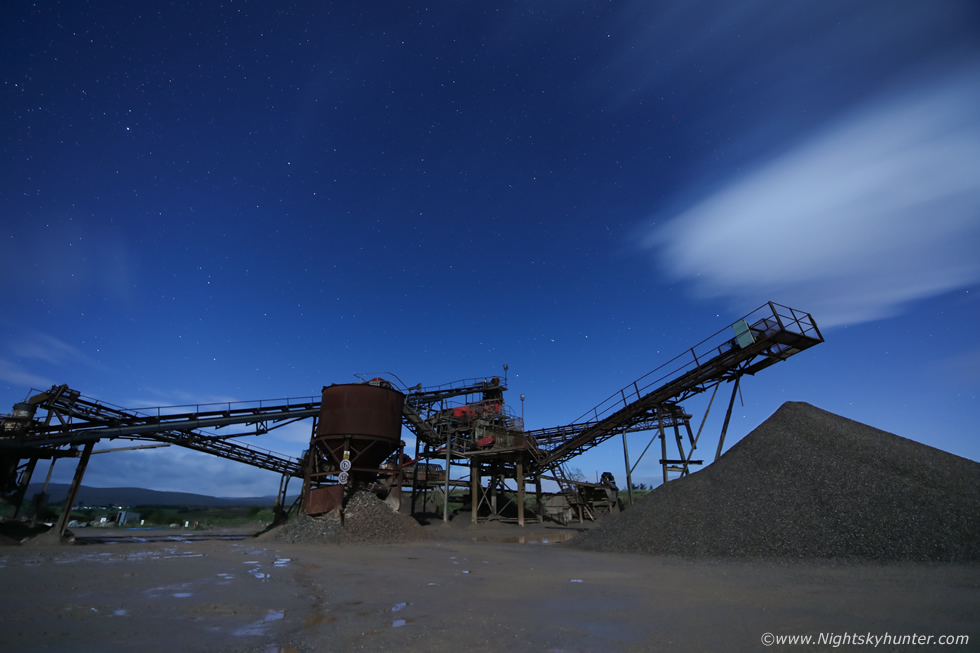 |
September 6th, eight days later I made a return visit to the quarry, this time I was with photographer Nigel McFarland, we had spent a couple of hours earlier shooting sunflowers in moonlight and then made our way back here, there was a cool breeze which kept the dew at bay and a cooler NWly flow which brought great clear spells and episodic cloud. The moon had waned but still bright enough to light up the foreground for us and we had a greater number of stars on view. I set up the 600D at 10mm for a star trail, well into the shoot interesting mid level lenticular clouds began to form and hover over the same area of sky, this is one of the images, the lenticulars are smoothed out in the exposure due to upper level winds, but that cloud formation remained stationary.
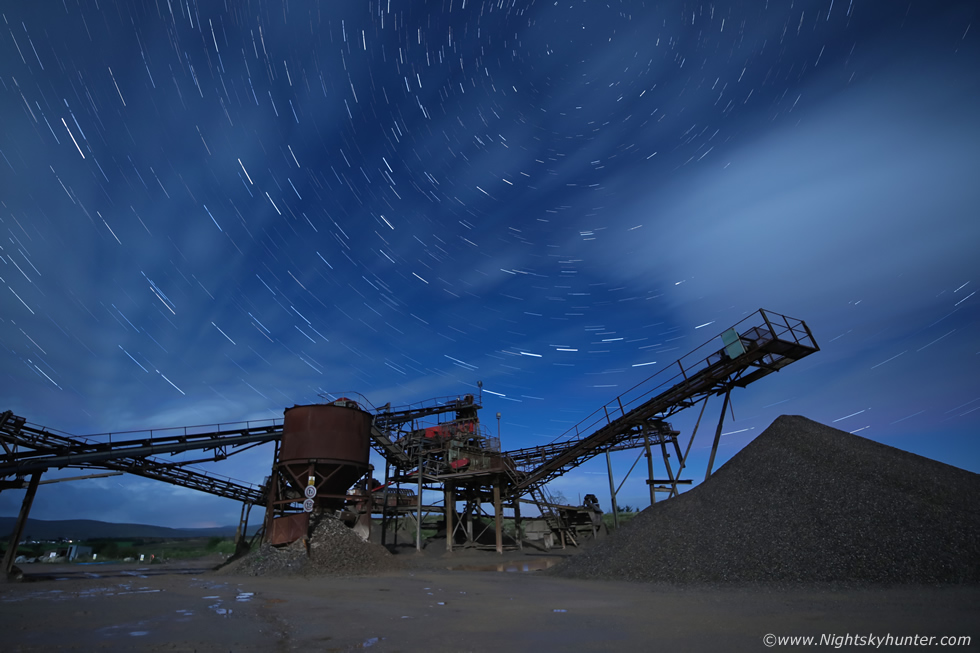 |
Star trail using same set-up, I could only use a sequence of frames with less cloud for stacking. Nigel and I let the cameras work away while we chatted and took in the sky.
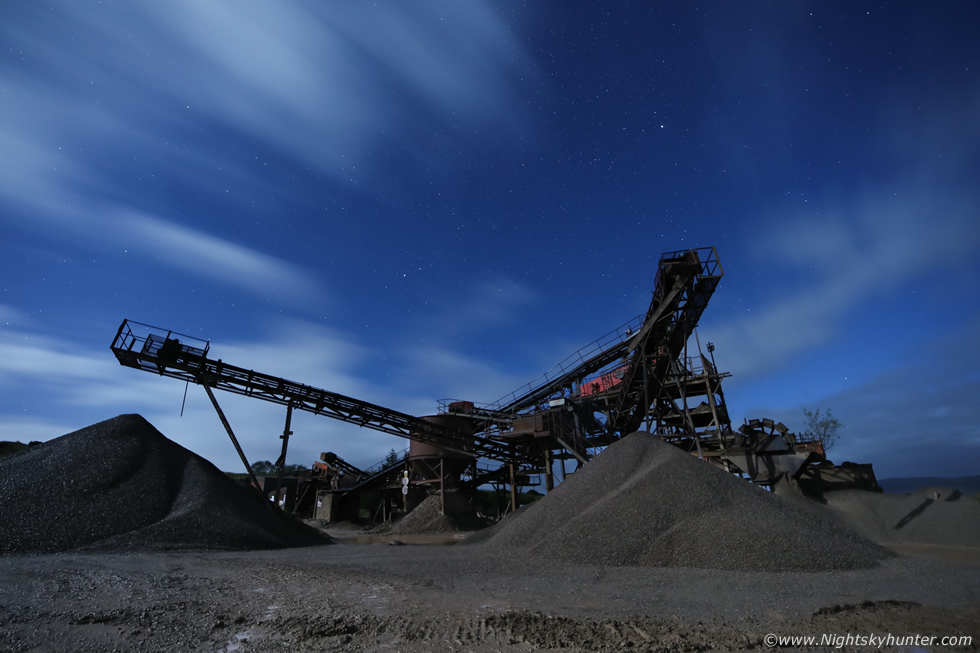 |
We could see an increase in high level cirrus cloud moving in so I took stills using the 5D at 15mm, Vega and Altair are the two brighter stars in the image.
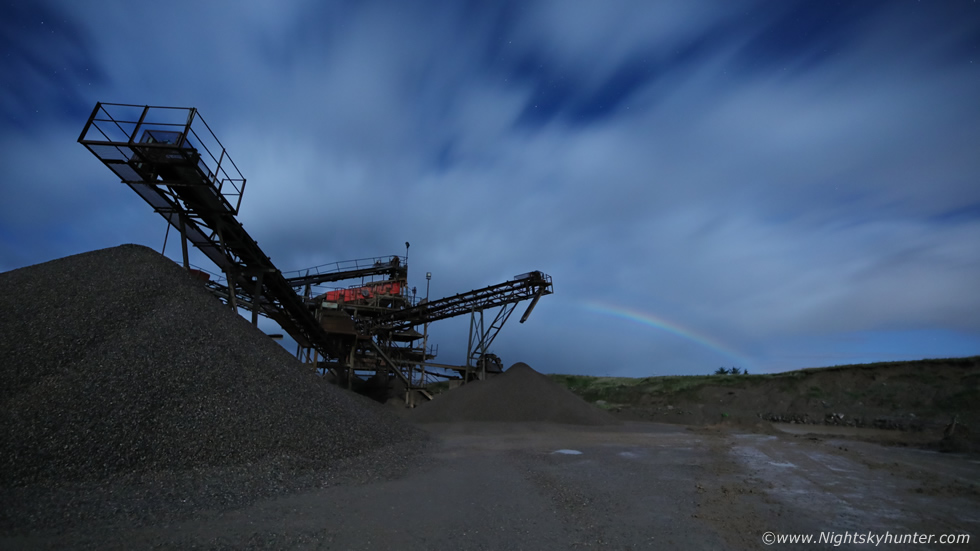 |
We spotted a fleeting moonbow, our first sighting of this phenomena this season. It was mostly pale white to the naked eye however I did perceive a subtle red colour to the upper edge visually.
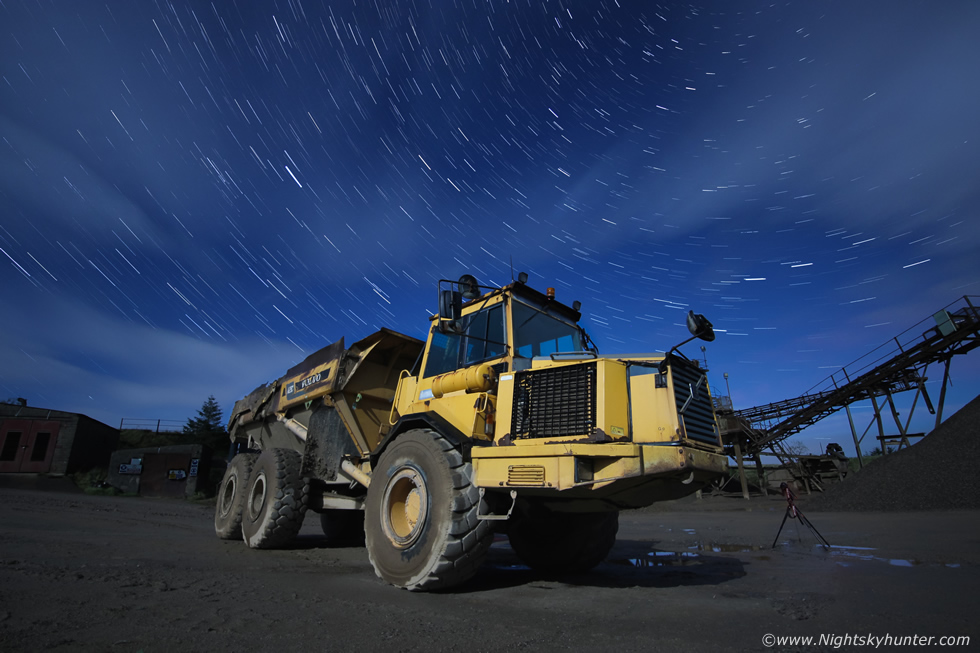 |
Dumper truck star trail illuminated entirely by moonlight, I accidentally placed my other camera in the frame, when I was on the other side I wrongly suspected the truck would hide the camera from this one, but it was a lot darker than it looks in this image so I made an error of judgment. I don't photo shop so I can't remove the tripod however I still love the image regardless. Standing in a quarry among the machinery at night is really surreal, its just such a bizarre experience, the machines almost look alien against the stars, the hills of sand and stone in the dull moonlight look like a landscape from Mars, not to mention the eerie feel yet at the same time peace and solitude, on occasion rats could be heard moving around and splashing in the water however they didn't bother us at all, we blended in with the night and became one with the place. Later increasing cloud and a cold wind ended our shoot. I really enjoyed it but hoped to get back for one last shoot here in a darker sky, I promised I wouldn't wait too long.
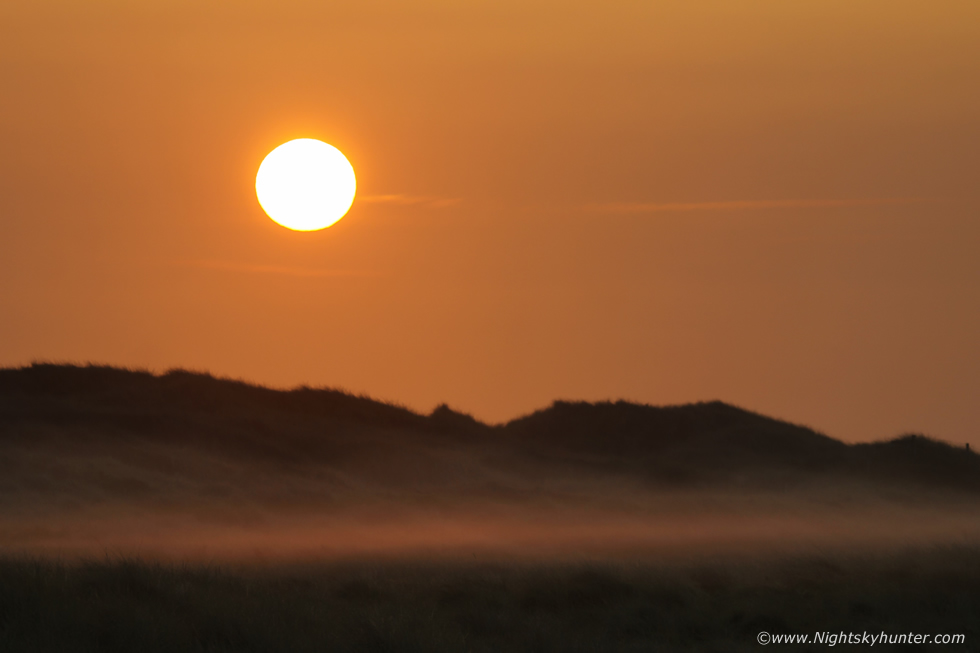 |
September 18th, sunrise from Magilligan Point while I was passing the road that morning. The disk of the sun rose vivid orange over the sand dunes and lit up banks of ground hugging mist, such a nice scene, this was with the 100-400mm.
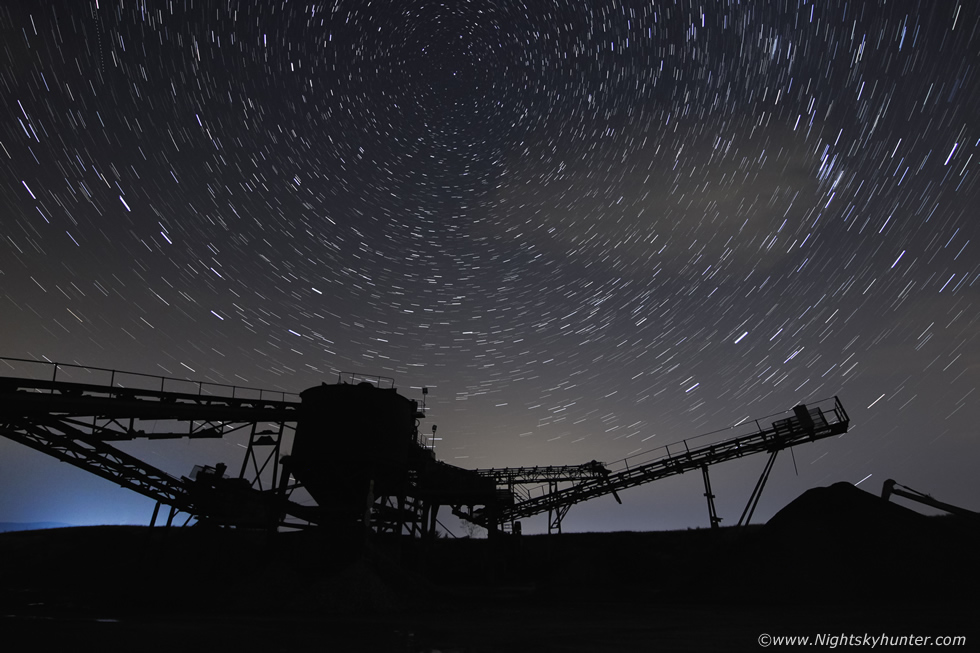 |
September 19th, my last visit, this time in the company of Paul Martin who had never been here before, he loved it and agreed it was completely different, when Paul and I really get into a shoot we tend to drift off and do our own thing then meet later. Paul was working out single shots and a star trail with the truck while I went back to star trails and time lapse. This was the first star trail, it should have been longer, however we saw suspicious activity near our vehicles and had to pack up the gear and sneak back to make sure everything was safe. We spent a good 30 minutes or more waiting to make sure the area was clear then returned to the site.
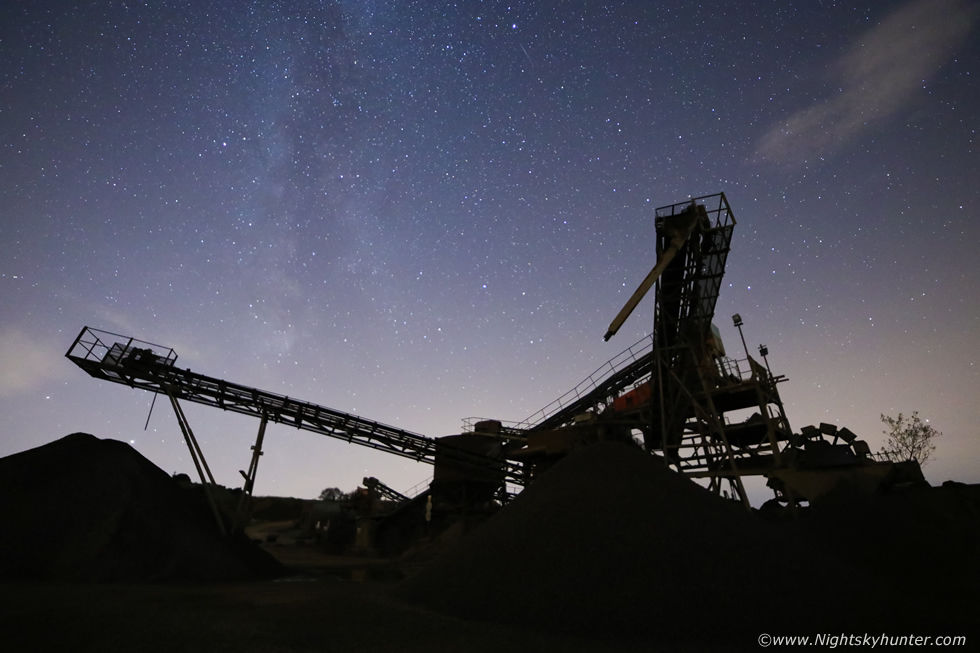 |
The sky was even better when we returned, vivid Milky Way and starscapes, no wind and dry and silent. It was a very comfortable night so we blended in well with the machines. I went back to my previous angle and now had the luxury of no moon and the Milky Way well placed, at first I thought it might not work as the foreground could be too dark without the moon however it worked out perfectly.
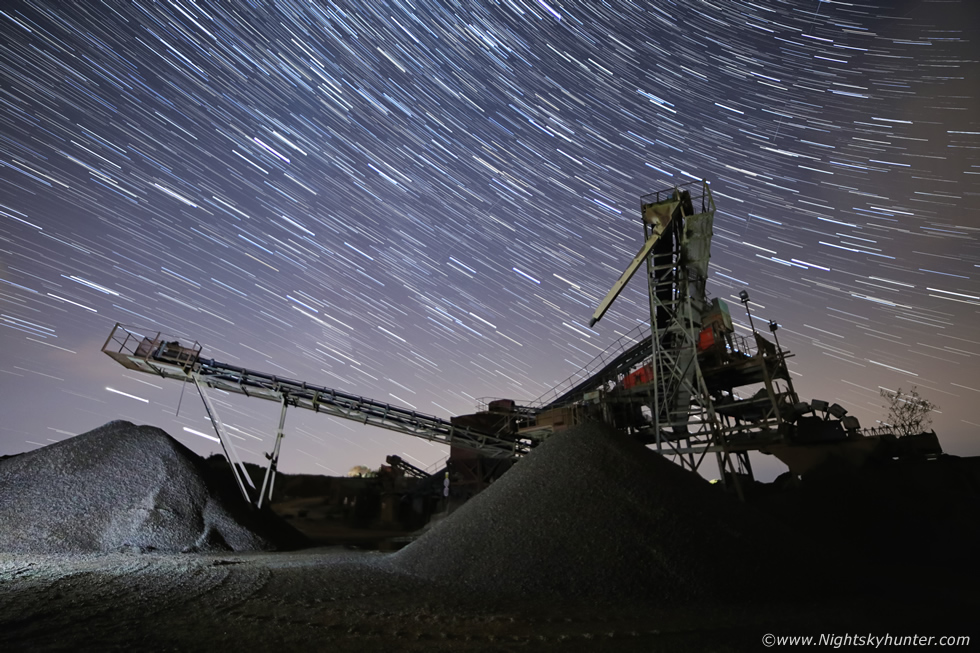 |
5D Mark IV star trail over stone separator, Paul was using a flash gun on the truck far off frame to the left and one of those flashes lit up the side of the scene, I liked it, so it was included in the final stack, very happy with this image, it isn't common to see quarry machinery with stars, certainly not in this country anyway.
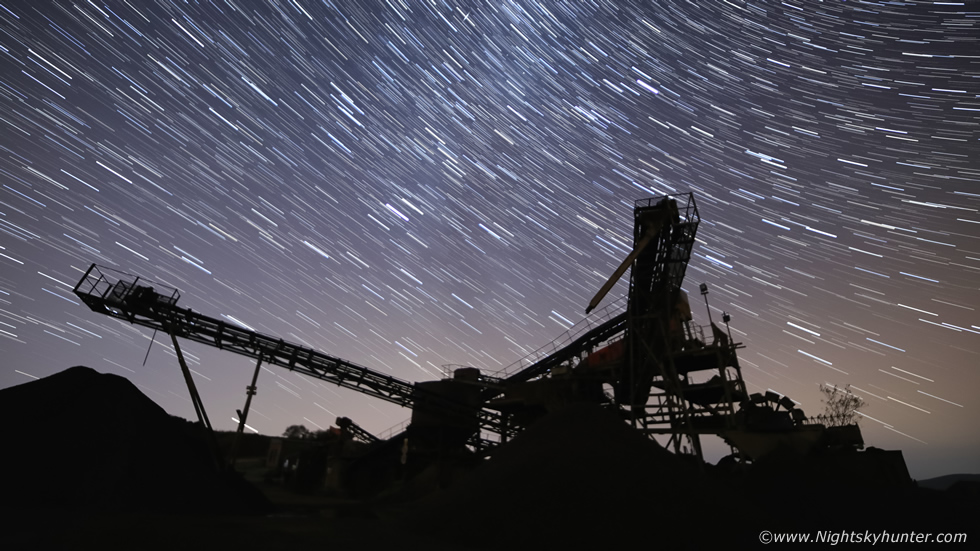 |
A second star trail sequence with no light, normally the best angle for star trails is the N, NE or NW to get the circumpolar trails however you can get away with shooting to the W too like here.
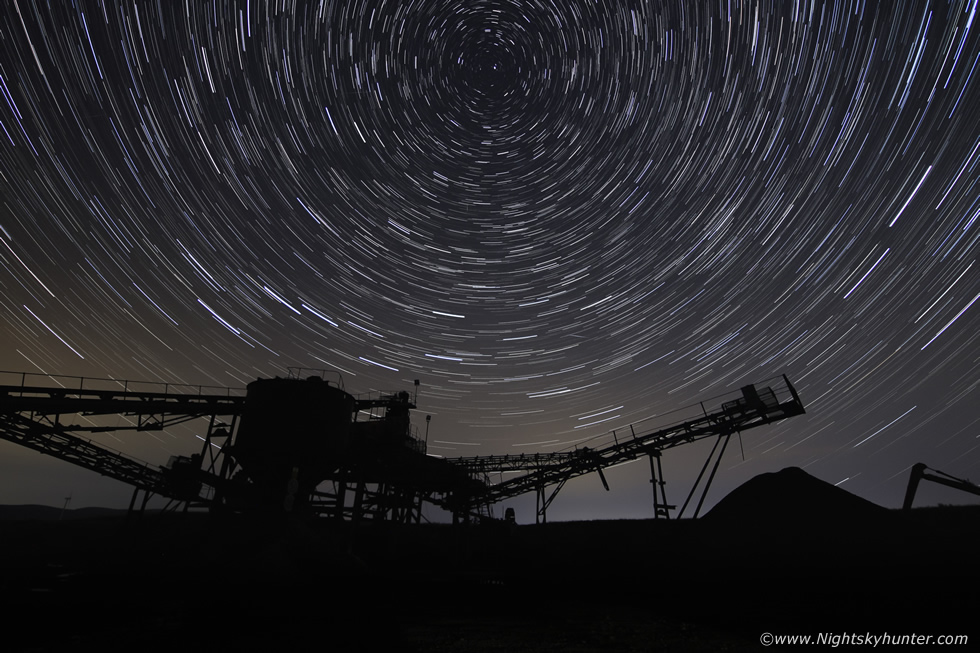 |
600D star trail second attempt from the first angle. We spent several hours here shooting, mostly in silence and enjoying the sky, this image sums up the scene. We called it a night after 02.00 and the timing was good as high level cloud soon moved in covering the stars. I have to say these three trips to the quarry were great fun, it was refreshing to do something different with unique foreground and a subject which I never thought I would tick off my list.
Time lapse sequence from three nights, two in moonlight and one under dark skies, as you can see the lapses were either cut short by unexpected cloud or because of the lens dewing over. After so many time lapse shoots getting ruined by mist on the lens I have come to the conclusion that I really need a dew removal system to make my time lapse shoots more efficient. This is a rather rushed image report but I wanted to get it online as I will be doing more night shoots in the near future. Thanks very much for watching.
Martin McKenna